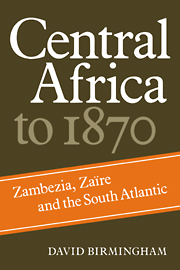2 - Kings and merchants in the Atlantic era 1600–1790
Published online by Cambridge University Press: 05 June 2012
Summary
the northern savanna and forest
In the seventeenth and eighteenth centuries the northern fringes of Central Africa made up one of the most sparsely populated areas of Africa. Here there were no great population clusters, no expansive cavalry empires, no walled cities and no markets thronged with caravans from the coast or the Maghrib. There were no kingdoms like those of Benin and Dahomey in West Africa and no mines as in Bambuk and Asante. The area had no wealth or minerals sufficient to attract traders across the Sahara. Only in the nineteenth century was its border pierced by Khartoum ivory hunters and Fulani slave raiders. Until that time the occupants of the northern savanna were almost exclusively concerned with subsistence agriculture. Even peoples like the Azande, who expanded the scope of their territory, did not expand the scope of their social institutions. Instead each advance swarm of Azande colonial pioneers cut itself off from its parent society and begun a new, independent, political existence. Not until the nineteenth century did the Bandia clan create the Bangassou ‘sultanate’ in order to resist the encroachments of slavers.
In the west, North-Central Africa had a small opening on to the maritime world of lower Guinea. This was through the Cameroun port of Duala. The small coastal kingdom of the Duala appears to have been founded by Bantu-speaking peoples from the surrounding forest in the early seventeenth century. They moved to the coast when the first Dutch sailors penetrated the Bight of Biafra seeking trade in exotic African curiosities.
- Type
- Chapter
- Information
- Central Africa to 1870Zambezia, Zaire and the South Atlantic, pp. 49 - 107Publisher: Cambridge University PressPrint publication year: 1982



